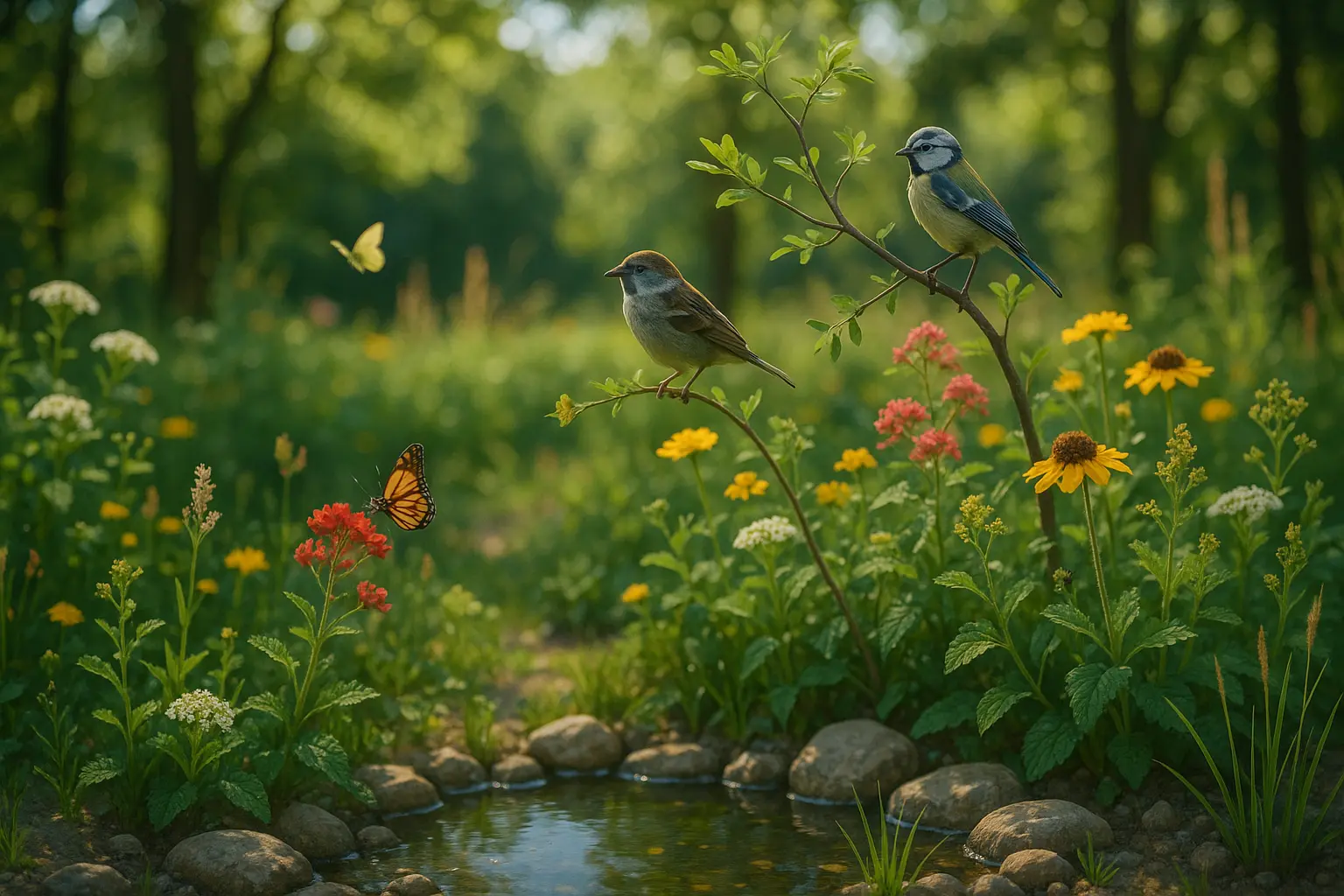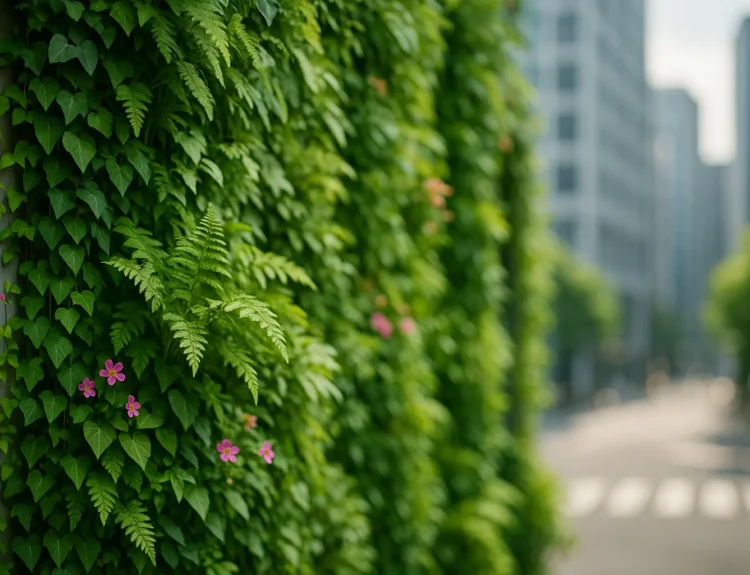The art of designing outdoor spaces has increasingly embraced a new paradigm—supporting local wildlife and fostering biodiversity. In an era where urban expansion threatens the natural habitats of numerous species, our gardens can serve as a sanctuary, a natural oasis welcoming diverse life forms. This is not just about saving the bees or planting a tree; it’s about creating a thriving, balanced ecosystem that benefits the flora, fauna, and humans alike. Imagine stepping into your garden, a world alive with vibrant colors, sounds, and movements. We have the potential to design such spaces, to create habitats that provide, protect, and flourish. As stewards of the land, it’s our responsibility to cultivate environments that celebrate life in all its forms.
The Power of Native Plants
Native plants are the unsung heroes of our landscapes, acting as the cornerstone of wildlife-friendly gardens. These plants, perfectly adapted to local climates and soils, offer numerous benefits that extend far beyond their aesthetic appeal.
Firstly, native plants require less water and maintenance. Their deep root systems improve soil structure, reducing erosion and increasing water infiltration. This means less watering and a happier garden that thrives even during dry spells. For instance, the resilient Purple Coneflower and the striking Black-eyed Susan are both native species that withstand drought conditions exceptionally well.
Furthermore, native plants are the primary caterers for local wildlife. They provide nourishment and shelter to various species, from pollinators like butterflies and bees to birds and small mammals. The absence of chemicals in these plants ensures a safer, toxin-free environment, promoting a natural food chain that supports a wide array of creatures.
Moreover, native flora enhances biodiversity. By establishing a diverse range of plant species, we create a habitat that supports not only the targeted wildlife but also the numerous interdependent organisms that sustain a healthy ecosystem. For instance, the presence of Milkweed supports the life cycle of the Monarch butterfly, enriching the garden’s biodiversity.
Incorporating native plants is not just an ecological choice but a cultural one. It allows us to reconnect with the land and history, celebrating the unique characteristics of our region while contributing to the global effort of preserving biodiversity.
Designing for Biodiversity and Wildlife
Creating a garden that champions biodiversity and wildlife involves more than just planting a few shrubs and trees. It requires an understanding of ecological principles and a commitment to enhancing the natural features of our environment.
The first step is to evaluate the existing landscape. Identify the natural elements already present and determine how they can be preserved or enhanced. This might involve retaining old trees, incorporating natural water bodies, or using existing rock formations to your advantage. Understanding the site’s microclimates and soil types will guide us in choosing appropriate plants and features.
Next, consider the structural design of the garden. A well-designed space will have multiple layers that mimic nature’s complexity. The incorporation of trees, shrubs, groundcovers, and climbing plants creates vertical diversity, providing various habitats and food sources for different species. This layering is crucial for creating a sustainable habitat that supports wildlife year-round.
Water is a life-giving force in any garden. Whether it’s a pond, a small stream, or a birdbath, providing water features will attract a myriad of species. Birds, amphibians, and insects are drawn to water, and its presence can make a dramatic difference in the biodiversity of an area. In addition, ensuring these water features are accessible and clean will maximize their benefit.
Lastly, integrating natural materials and features enhances the habitat and aesthetic appeal. Logs, stones, and native grasses can serve as homes for insects and reptiles, while also adding texture and form to the garden. By designing with nature, we create a space that is not only visually stunning but also functionally diverse.
A Commitment to Sustainable Gardening Practices
Our gardens must reflect our commitment to sustainability and ecological awareness. Adopting practices that minimize environmental impact while maximizing benefits for biodiversity is crucial.
Avoiding chemical fertilizers and pesticides is a vital step. These substances can harm wildlife and diminish soil health. Instead, we can use organic compost and natural pest control methods. Companion planting, for example, is a technique where various plants are grown together to deter pests naturally and promote health.
Another essential practice is mulching. By covering the soil with organic materials like leaves, bark, or grass clippings, we can retain moisture, suppress weeds, and improve soil fertility. This not only reduces the need for watering but also provides a habitat for beneficial insects.
Creating a wildlife-friendly garden also involves leaving certain areas undisturbed. A pile of leaves, a stack of logs, or a patch of wildflowers might seem untidy, but they serve as crucial habitats for insects, reptiles, and small mammals. These areas offer shelter, breeding grounds, and food resources, fostering a rich tapestry of life.
Finally, reducing our garden’s carbon footprint can be achieved through smart design choices. Utilizing local materials, recycling garden waste, and incorporating energy-efficient lighting and tools reflect our dedication to sustainable living.
By embracing these sustainable practices, we not only enrich our gardens but also align ourselves with the broader movement towards environmental consciousness, ensuring that our actions today have a positive impact on tomorrow.
The Role of Community and Education
Designing wildlife-friendly spaces is a collective endeavor. While individual gardens can greatly contribute to local biodiversity, community involvement amplifies these efforts, fostering a culture of ecological responsibility and awareness.
Community gardens offer an excellent platform for education and collaboration. These shared spaces allow us to experiment with diverse planting strategies, learn from one another, and cultivate a collective vision for biodiversity. They also serve as living classrooms where we can engage with the younger generation, teaching them about the importance of ecosystems and the role they play in sustaining life.
Workshops and seminars are excellent tools for spreading knowledge and sparking interest in wildlife-friendly gardening. By inviting experts and enthusiasts to share their insights and experiences, we can inspire participation and ensure that informed decisions are made when designing and maintaining spaces.
Moreover, partnerships with local environmental organizations can provide valuable resources and support. These collaborations can lead to improved conservation strategies and greater awareness of regional ecological needs.
Finally, harnessing the power of digital platforms allows us to share our successes and challenges with a broader audience. Social media groups, blogs, and forums are vibrant spaces where ideas can be exchanged, and community ties strengthened.
Together, by pooling our knowledge and resources, we not only create thriving ecosystems but also foster a sense of stewardship, ensuring that biodiversity becomes a community-driven value.
As custodians of our gardens, we hold the power to create environments that nurture life and enhance biodiversity. Through thoughtful design, the use of native plants, and sustainable practices, we can transform our outdoor spaces into thriving habitats that support and celebrate the natural world.
This journey is not a solitary one. It is a collective movement towards harmony, a commitment to preserving the intricate tapestry of life that surrounds us. By sharing knowledge and engaging in community efforts, we sow the seeds of ecological awareness and responsibility.
Let us embrace this opportunity to create landscapes that reflect our dedication to sustainability and biodiversity, leaving a legacy that resonates with future generations. Together, we can sculpt spaces where nature and humanity coexist in vibrant harmony.
FAQ
How can I create a wildlife-friendly garden in my backyard?
To design a wildlife-friendly garden, start by incorporating native plants that provide food and shelter for local species. Include a variety of plant types, such as trees, shrubs, and wildflowers, to create diverse habitats. Water features, like birdbaths or small ponds, can also attract different species. Avoid using pesticides to protect the ecosystem and encourage natural pest control.
What types of plants are best for attracting pollinators like bees and butterflies?
Choose native flowering plants with a range of bloom times to provide food throughout the growing season. Brightly colored flowers, particularly those in shades of purple, blue, and yellow, are known to attract bees and butterflies. Examples include coneflowers, milkweed, lavender, and sunflowers. Clusters of flowers can make it easier for pollinators to find their way to your garden.
How can I make my outdoor space more welcoming to birds?
To attract birds, provide a mix of trees, shrubs, and grasses that offer food and nesting opportunities. Install bird feeders with seeds, suet, or nectar to supplement their diet. Provide a source of fresh water, such as a birdbath or a small fountain. Avoid pruning trees and shrubs during nesting seasons to protect nesting birds.
What are some ways to support small mammals in my garden?
Create small brush piles with sticks and leaves to offer hiding spots and shelter for small mammals. Plant ground covers and dense shrubs to provide protection from predators. Leaving patches of your garden with longer grass or wildflowers can create a natural habitat for small creatures. Provide water sources like shallow dishes or small ponds to meet their hydration needs.
How can I design my outdoor area to support amphibians and reptiles?
Incorporate features like rock piles, log piles, and leaf litter to provide shelter and basking spots for reptiles and amphibians. Ensure there are shallow water sources, such as a pond with sloping sides, to accommodate amphibians. Preserve some damp, shaded areas in your garden to maintain suitable conditions for these creatures.



